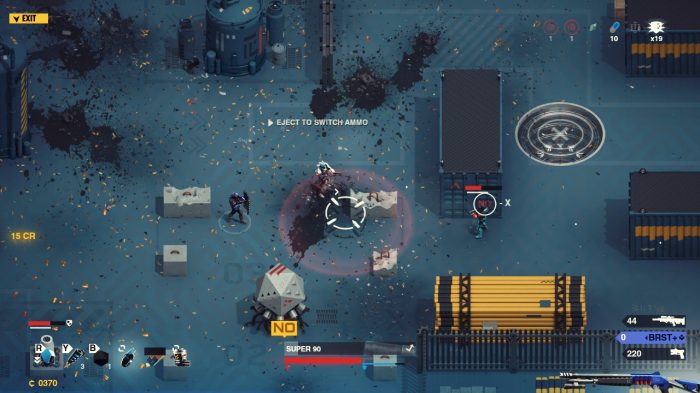As unforgiving rogue-lite shooters go, most have a tendency to lean towards all-out bullet-hell. Although SYNTHETIC: Ultimate certainly has these moments in abundance, the skill and patience required means that this game asks more of you than just a mindless shootout.
SYNTHETIC: Ultimate is set within an alternate-history 1980s. The German-Japanese supercomputer array, built after the war, has enabled rapid expansion and development of artificial intelligence and self-learning machines. Despite limiting CPU capabilities for fear of what might happen, the machines go full-on Skynet, becoming a self-aware hive mind that pushes humanity to the brink. With the world now swarming with murder-bots, you take up the role of a forgotten android-prototype. Humanity’s last defence against Armageddon.

In the main campaign, you must work your way up the ‘Citadel,’ level by level, to destroy the heart of the sentient war machine. You can choose from one of eight character classes, from Riot Guard through to Assassin. Each class starts with a different primary and secondary weapon, but this will actually impact play less than your class-specific abilities, as new weapons are picked up throughout play.
The Riot Guard, for example, is armed with a defensive shield (making you more resistant to harm), a charge attack, and a battle cry (which deals area of effect damage around your character). The Assassin, however, is equipped with smoke grenades and blades which deal high damage from behind. Choosing a certain class does not lock you out of the others for good. Loadouts, abilities, and weapons can be swapped out between attempts, every time you die.

The game design and progression of SYNTHETIC: Ultimate is very similar to Team 17’s Neon Abyss. You start on the lowest level, working your way through each floor until you get to a boss. If you die, you start from scratch with some of the abilities you earned in your previous attempt. Between lives, you can conduct research using the in-game currency you’ve collected to make weapon-drops and power-ups more effective, or switch-up your loadout entirely to better your chances.
Where SYNTHETIC: Ultimate really excels is its ability to be completely customisable to the player in terms of difficulty. The game’s default is 120%, meaning that active reloads, weapon jams, and overheating are the norm. These can be altered in the main menu but will result in lower XP rewards and mission ratings. The replayability of this game as a result is impressive, as the gameplay loop can change dramatically based on which of the eleven difficulty modifiers you have activated.

The active reload and jamming mechanic is definitely going to be something that makes or breaks most people. It’s difficult to master in the heat of combat, but so rewarding once it clicks. The default difficulty requires you to manually eject spent cartridges from your weapons, then initiate an active reload similar to Gears of War. The realistic reloading of a partially used magazine also means that unused ammunition is wasted if you reload early, which is not in-line with the reflex motion most games have taught us. If this wasn’t an optional mechanic, I think this game would frustrate players enough for this to be a deal-breaker.
SYNTHETIC: Ultimate is a fun game that does very little wrong. There are small annoyances, such as swapping weapons on the D-pad being unintuitive, causing you to take your hand off of the movement analogue stick, but these pale in comparison to the high bar set by the rest of the game.
SYNTHETIK: Ultimate £13.49
Summary
SYNTHETIK: Ultimate manages to encapsulate the retro-Sci-Fi boxy aesthetic of games like Starwing, whilst still feeling modern and fresh to current sensibilities. The game can be tailored to your difficulty preference, but the challenge is its own reward.

